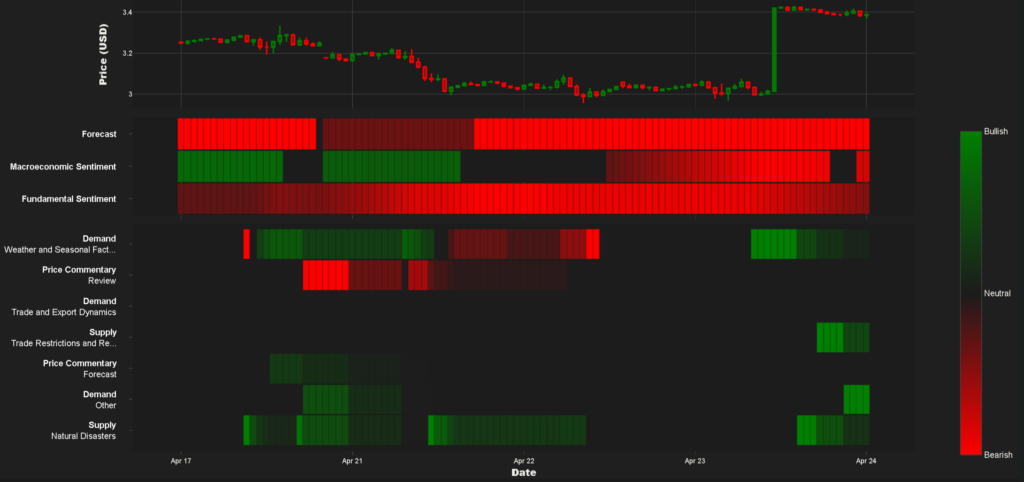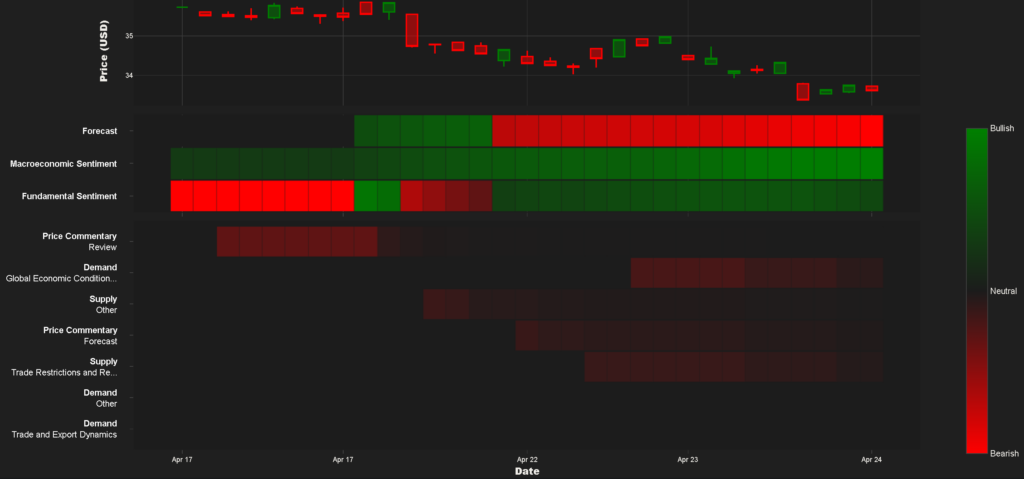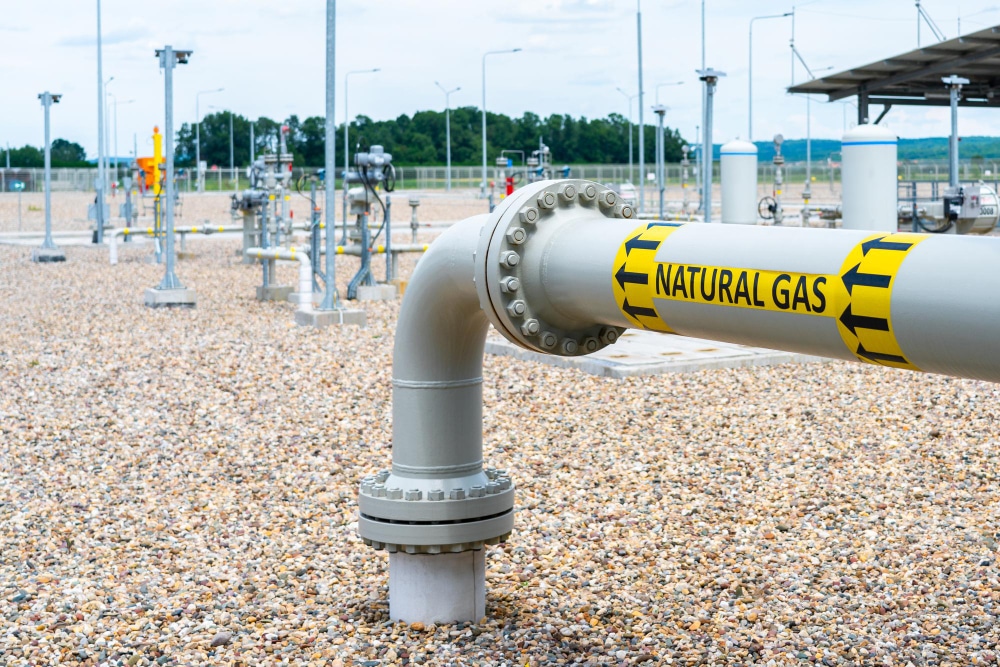This article provides an in-depth analysis of the complex factors currently driving natural gas price volatility with insights taken from Permutable AI’s data insights, aimed at energy traders, portfolio managers, risk analysts and commodities professionals seeking to understand the intersection of weather patterns, geopolitical tensions, and market fundamentals affecting the gas markets.
The volatile nature of natural gas markets
The unpredictability of natural gas prices has reached new heights as multiple forces converge to create an increasingly complex market landscape. Our recent market sentiment data across both Henry Hub and European TTF markets reveals an intricate interplay of weather patterns, geopolitical tensions, and supply-demand dynamics that are collectively shaping natural gas prices now. Our analysis of these trends through the lens of our latest data insights highlights several important factors that traders and energy stakeholders should monitor closely.
Weather patterns: The persistent market mover
Looking at Henry Hub natural gas over the past week reveals weather as perhaps the most immediate driver of natural gas prices now, with volatility evident in the latest data showing prices ranging from $3.39 to $3.42 on April 24, following a slight recovery the previous day when prices opened at $3.43 and closed at $3.42, supported by forecasts for cooler temperatures across the U.S.
This continues the pattern observed in earlier market activity, where severe weather systems moving across key consumption regions directly influenced both supply and demand. The deadly storms over the Easter weekend across Oklahoma and Texas created significant market uncertainty, with prices opening at $3.66 on April 21 and closing significantly lower at $3.49, driven by ongoing severe weather forecasts.
What’s extremely apparent is that these weather-driven fluctuations aren’t merely seasonal anomalies but are becoming more pronounced and less predictable, creating additional challenges for market forecasting. The situation has been exacerbated by increasing climate variability, making traditional weather-based trading models less reliable for natural gas prices.

Above: Market sentiment indicators affecting natural gas prices now
Geopolitical tensions: The European dimension
The European TTF market continues to respond dramatically to ongoing geopolitical developments. Our latest analysis shows that European natural gas prices are continuing to be particularly sensitive to events in Ukraine and Russia’s strategic energy decisions.
On April 24, prices opened at €34.33 but declined to €33.38 amid reports of a decrease in Norway’s gas output. More significantly, the Kremlin’s announcement of a standstill in gas supply talks with Europe further contributed to bearish sentiment. This follows a pattern of volatility where on April 22, TTF prices opened at €35.54, initially rising to €35.84 before dropping significantly to €34.25 as the market reacted to escalating conflict.
The era of energy security being taken for granted has clearly and categorically ended. The resumption of hostilities following the Easter ceasefire has amplified market anxiety about gas supply stability in Europe, with reports indicating numerous Russian drone attacks and military actions. The deadly Russian drone attack on Marhanets on April 23, which resulted in civilian casualties, further complicated the geopolitical landscape. The blowback could extend to global LNG markets as Europe seeks alternative supplies, potentially redirecting cargoes from Asia and affecting global natural gas prices.

Above: Market sentiment indicators affecting European TTF natural gas prices now
Supply-demand balancing act
Across all these fronts, the fundamental supply-demand equation continues to underpin natural gas prices. The latest data shows that on April 22, prices ranged from $3.41 to $3.50, closing at $3.43, as the market faced pressure from reports of significant builds in U.S. natural gas inventories, attributed to warm spring temperatures.
This brings us back to a crucial market dynamic: natural gas prices reflect not just current consumption patterns but expectations about future storage adequacy. The April 24 data indicates that rising LNG demand and ongoing maintenance activities affecting supply influenced price declines, with prices dropping to $3.39 early in the day. Additionally, an emergency order to accelerate permitting for oil and gas projects was enacted, which may have contributed to market volatility.
The question remains whether current inventory build rates will be sufficient to meet potential future demand spikes. Those who ask whether the market is adequately pricing in potential supply disruptions might find the answer uncertain, particularly when examining the Henry Hub Weekly Overview where prices have ranged significantly in a single week.
Interconnected global markets
Natural gas prices increasingly reflect the globalization of gas markets. The latest TTF data shows how European concerns about supply have kept markets on edge, with prices responding to reports of a decrease in Norway’s gas output and the Kremlin’s announcement regarding gas supply talks.
It’s notable that Henry Hub natural gas prices now show increasing correlation with international events that previously would have had minimal impact. Our data indicates that rising LNG demand influenced price movements in the U.S. market, highlighting the interconnected nature of global energy markets. This puts the onus on market participants to broaden their analytical scope beyond regional fundamentals.
Market sentiment and trading patterns
Natural gas prices also reflect shifts in market sentiment that can sometimes override purely fundamental analysis. The recent price movements at Henry Hub on April 23-24 suggest traders may be recalibrating their positions in response to cooler forecasts and supply concerns.
As the reality of changing market dynamics sets in, we’re observing more cautious trading patterns overall. But that outcome isn’t guaranteed to persist, especially with weather uncertainties and geopolitical tensions remaining high. The recent emergency order to accelerate permitting for oil and gas projects may introduce new variables into the market equation, potentially shifting natural gas prices in either direction.
Navigating this complex landscape
Clearly, natural gas prices represent a culmination of multiple factors that require sophisticated analysis to navigate effectively. Over the last week, we can see just how quickly prices can shift. Ultimately, the unpredictability of natural gas prices demands a multifaceted analytical approach that can integrate weather forecasting, geopolitical intelligence, supply-demand fundamentals, and trading pattern analysis. Given the complex interrelationships between these factors, isolated analysis of any single variable is becoming increasingly insufficient.
What’s painfully apparent is that market participants require more comprehensive analytical tools that can process these various inputs simultaneously. The era of simple price forecasting based on historical patterns has given way to a more dynamic approach that accounts for the increasing volatility and interconnectedness of global energy markets.
Take action now
Access our real-time market sentiment data to gain the competitive edge needed to understand natural gas prices now in today’s volatile markets. Our comprehensive market sentiment data integrates multi-dimensional analysis of weather patterns, geopolitical developments, and supply-demand dynamics to provide actionable insights for your trading decisions. Request a demo to see how our cutting-edge sentiment analysis tools and feeds can help you stay ahead of market shifts and uncover opportunities to inform your trading strategy. Simply email us at enquiries@permutable.ai or fill in the form below.
